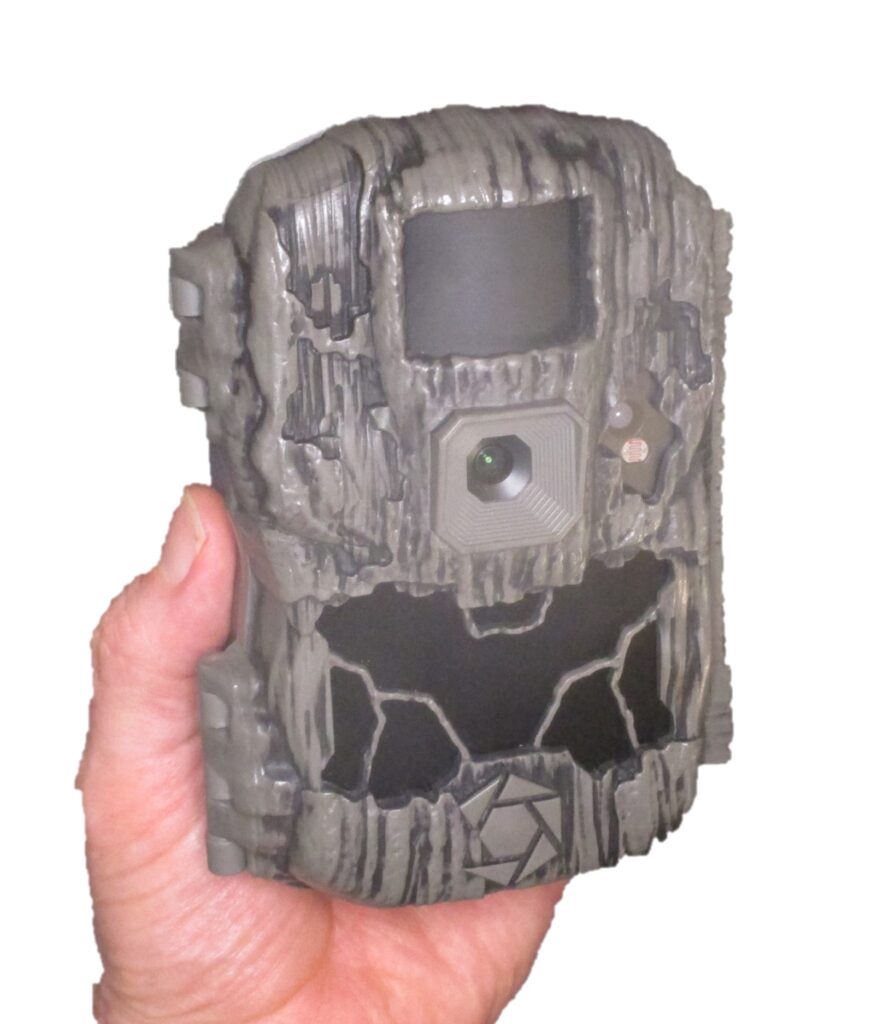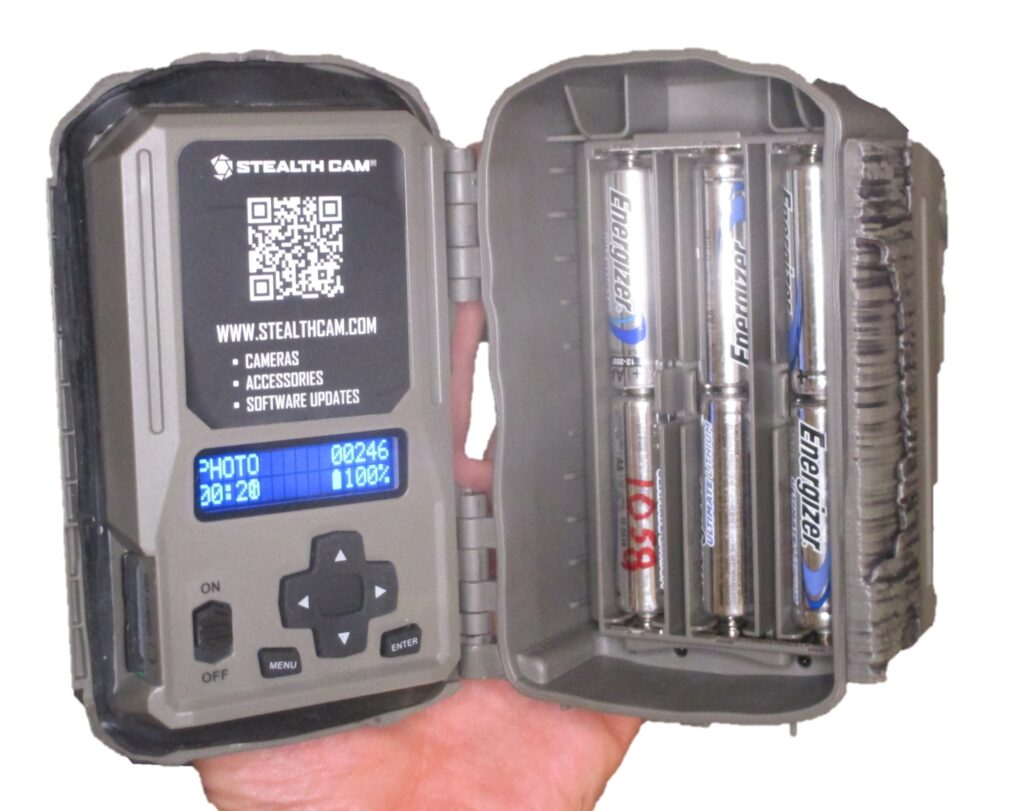Inside the Stealth Cam DS4K Trail Camera
The Stealth Cam DS4K Ultimate is in a class of mid-priced camera aiming to give excellent image and video quality, and a standard set of features. In this post I’ll be taking a look at the major features, video and audio quality, and finally taking the camera apart to better understand what’s inside. I also provide a teardown video to guide anyone wishing to take apart this camera to debug or repair. This post is not intended as a comprehensive review of all the camera features, photo quality, trigger speed, etc. For these, I recommend the detailed product reviews posted at Trailcampro.com.

Impressions
The DS4KUltimate uses a “clamshell” design, in which the entire case opens to reveal a battery compartment and programming interface. A couple of things to note with this model. See the online manual for details on the features available through the User Interface.
With More Power Comes Larger Size
At 9.0 x 15.0 x 8.3 cm (1120 cm^3), this camera is noticeably larger than others in it’s class. One reason is that it takes 12 AA batteries, vs. the more typical 8 (or 6) batteries. When used with a security box, a larger camera requires a larger, heavier security box. Depending on how many you’d like to fit in your backpack, this may or may not be an issue for you.

I suspect the larger battery pack is required because the camera consumes more power when taking photos and videos than some of it’s competition. This higher power seems independent of resolution and weighs in at ~2.4 Watts while taking unlit video. Compare this to ~1.7 Watts for Browning Elite HP5, and ~1.0 – 1.3 Watts for Bushnell Core DS 4K. I suspect that Stealthcam is using a less efficient camera chipset, but I can’t be sure because it’s covered by an unremovable metal heat sink.
Alphanumeric Display
The DS4KU has a 2-line illuminated alphanumeric screen to aid in camera setup. Although the characters are large, and high contrast, and easily read, this display cannot be used to review photos and videos in the field.
Great Sound
I found the DS4KU to have superior audio quality. This despite a microphone mounted facing down from the bottom of the case. You can listen for yourself in the video examples below.
In my teardown video, below, I note a digital MEMS microphone on this camera vs. the more typical analog electret microphone(s) found on most other cameras. Digital MEMS microphones have become the standard technology for cell phones because of their small size, immunity to electrical noise, and excellent audio quality. It’s good to see this technology in a trail camera.
Fewer Features
The DS4KU has most of the features found in this class of trail cameras, but it is missing a few. These include: no setting for PIR sensitivity; and no setting for flash power. On the one hand, this simplifies the configuration menu. On the other, it gives fewer options to fine tune a set. It is also missing an “aim test” mode, which can be useful in the field, or in mapping the camera’s detection zones.
6 or 12 Batteries in a Removable Case
The battery case includes a removable cartridge, which is easier to load with batteries vs. some clamshell models.
In a feature not mentioned in the instruction manual, the camera will operate with only 6 AA batteries installed (all on one side or the other of the carrier). Of course, with half the batteries, the camera will last half as long. Still, this could be useful for shorter duration sets.
Video Examples
The STC-DS4K ulimate has 4 options for video resolution, including the namesake “4K (3840 x 2160)” option. In the video below, I compare these resolution modes in daytime settings. Unfortunately, there is no resolution option that offers a faster (e.g. 60 FPS) frame rate, vs the supported 30 FPS for all resolutions. Judge for yourself based on video, but my preference would have been for an option with 60 FPS frame rate, even if it meant lower resolution video.
| Shorthand | Video Resolution | Frame Rate (FPS) |
| 4K | 3840 x 2160 | 30 |
| QHD | 2560 x 1440 | 30 |
| — | 1920 x 1080 | 30 |
| — | 1280 x 720 | 30 |
Detection Zones
The DS4K Ultra doesn’t have an “aim test LED”, so I used an alternate method described in Deep Tech: Trail Camera Detection Zones to map its detection zones. Dark circles inside detection zones are actual triggers due movement of a a small thermal target.

Stealth Cam DS4K Trail Camera Video with Teardown
The video below goes through many of the points of this post and also features a teardown section showing how most of the internal pieces come apart and go back together. As with most trail cameras, this is not recommended by the manufacturer and may void the warranty. Having taken the plunge myself, though, here are a few interesting things I found.
Beware Glued-on Gasket
Note that the the gasket which seals the clamshell is glued on very securely.
I tried to gently pull the gasket off of the glued spots, but ended up tearing (and ruining) the gasket in the process. I had to make another out of some rubber gasket material I had left over from a previous project.
If you open up this camera, I suggest using a very sharp hobby knife to gently cut through the adhesive holding the rubber gasket in place at several spots.
Final Take
The Stealth Cam DS4K Ultimate has a lot going for it. High quality video and superb audio are it’s main strengths. The lack of an LCD screen to run the user interface is a major shortcoming, and its absence is a bit of a mystery in a camera marketed as “ultimate.” Still, the alphanumeric display is large, bright and clearly legible in field conditions. I would rank “build quality” as below average, as there are lots of fine wires tacked onto the main PCB with solder — a method known to lead to manufacturing errors. I would rather see fewer such connections and/or more use of removable connectors. Finally, the power consumption on this model is disappointingly high, driving a large size box and increased consumption of batteries.
Do you have a Stealthcam DS4K Ultimate? What’s your experience, good or bad? Please comment below.
I will give the camera I used for this review to the first (non-prior “winner”) to ask for it in comments below.
Acknowledgements
I would like to thank Trailcampro.com for donating, with no strings attached, the stock camera I used for this post.

Hi I loved the review of this camera and all of your tear down style reviews. Always lots learned! If no one has asked for the camera yet I would like it! I have lots of wildlife observation opportunities and have a great spot in mind to try this camera! Let me know, thanks.
I’m glad you find these reviews valuable. And… you’re the first to ask, so this camera is yours. Stay tuned for an email.
I have 2 older DS4K cameras. Considering a new DS4K. Thanks for the review. Signed..Prior Winner!
Glad you find these valuable — and good luck with the new camera!
Great review. Love seeing the tear downs. I’d never heard of mems mic’s until I opened up my spypoint flex and niw reading your comments on it, seems noisier than the electret mic’s
Regards
Mark